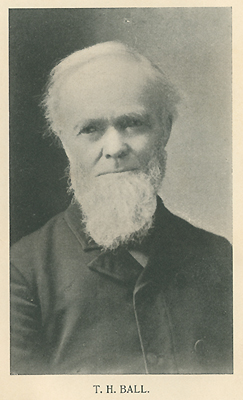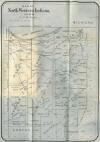Northwestern Indiana from 1800 to 1900A regional history written by Timothy H. Ball . . . .
Source Citation:
Ball, Timothy H. 1900.
Northwestern Indiana from 1800 to 1900 or A View of Our Region Through the
Nineteenth Century. Chicago, Illinois: Donohue and Henneberry. 570 p.
NORTHWESTERN INDIANA FROM 1800 TO 1900
5
INTRODUCTION.
This work will include, in the term North-Western Indiana,
all the area between what is known in the United States survey as the Second
Principal Meridian and the Illinois State Line, from
township 26, northward to the Indiana
Boundary Line. The width of this region is thus nine ranges and about one
section, or fifty-five miles, and its length is nearly twelve townships, or
about seventy-two miles, making an area, including a part of Lake Michigan, in
even numbers, of 3,960 square miles.
In this area are seven entire counties and parts of two others, but only a very
small part of Cass County, and the counties to be included in this history, as
forming North-Western Indiana, are Lake, Porter,
LaPorte, Starke, Pulaski, and White, and Newton and Jasper.
It will thus, at the southeast corner of the parallelogram, barely touch the
Wabash River a few miles from Logansport. The
Tippecanoe, the Iroquois, the Yellow, the Kankakee, and the Calumet, are its
principal rivers.
In thus taking the second principal meridian as the limit eastward of
North-Western Indiana there are left for
North-Eastern Indiana fourteen ranges, or thirty
miles more than one-half of the full width of the State.
The entire history of this region, in much detail, could not in a volume of this
size be given; but in-
6
teresting and certainly valuable facts connected with
its early settlement and growth, will here be found, some of which can be found
nowhere else; and the author believes that the condensed and the detailed
history and the gathered facts and incidents, as arranged in this book, will be
an acceptable and a valuable addition to the accumulating store of our historic
treasure, as we are in Indiana,
closing up one century of progress and closing up at the
same time the Nineteenth Century of the Christian Era.
In regard to the sources of information for the statements contained in this
work, the author can claim, in the first place, some personal knowledge derived
from his own observation, as he has had a home in
this region since 1837, coming here from the State
of Massachusetts in the spring of that year, when eleven years of age (old
enough to observe, and, as he had then studied Latin and Greek in academies and
high schools, cultivated enough to discriminate and make records); and since
1875 he has been the Historical Secretary of the Old Settlers' Association of
Lake County: and, in the second place, he has availed himself of the helps
furnished by different County and State publications. Especially
from an Illustrated Historical Atlas of
Indiana, published in 1876, by Baskin, Forster &
Co., he has taken many statements of early times and of settlements in counties
which his personal knowledge did not reach, statements in regard to those early
years which could not now be obtained. That historical atlas is a valuable work
for Indiana up to 1875.
That some corrections would need to be made, and that room would be found for
desirable additions, in the historical writings of those who have gone before
7
him in giving county history, might naturally be
expected, and from
his long residence in this region, while most of those writers referred to have
been nonresidents and strangers, and on account of his special training and the
line of work which for many years he has pursued, the author of this book
believes that the readers will find here some carefully prepared and quite
accurate history, and he cherishes the hope that it will become a recognized
authority, in its special lines of treatment, concerning North-Western
Indiana.
It is hoped that no apology is needed for inserting here the rather lengthy
extracts that follow.
Well said Dr. Baron Stow, of Boston, at a large religious semicentennial in
1864, speaking of the disposition of aged persons to give reminiscences of their
youth, "this tendency to retrospection and historical narration is not merely an
accident of human decline; it is a beneficent arrangement of Divine Providence.
In all education, experience renders an important service, and for its teaching
there is no substitute. 'Thou shalt remember all the way in which the Lord thy
God hath led thee.' 'One generation shall praise Thy works to another, and shall
declare Thy mighty acts.' The past is thus brought forward into the present; the
stream of tradition is kept running; and, while the less valuable facts may be
precipitated and left by the way, the more important are borne along as
materials for the continuous history of our race. * * * The world and the church
of our times do well to understand how much they are indebted to the memories of
the more aged as the successive reservoirs of facts, and now much also, to what
are thoughtlessly called the garrulities of age, for the communication of those
8
facts. If it is an ordering of Providence that every generation shall create a
portion of history, it is equally intended that every generation shall convey to
its successor all that is worthy of transmission. * * * The successive
generations overlap one another in precisely the way to form a continuous
channel for the traditionary current." ["The Missionary Jubilee." Pages 91, 92.]
THE PLAN OF THIS BOOK.
In giving a
view of North-Western Indiana for one hundred
years, or through the Nineteenth Century, it is not proposed to give a
continuous history of this region, county by county and township by township, as
it is now divided and subdivided; but, while recognizing these divisions as they
now exist, it is proposed to give the history of the region as a whole, to show
its early settlement, its growth, and what it now is, by treating in separate
chapters, as topics or subjects of interest, the various particulars which
belong to its topography, its physical features, and its general history. The
reader who will look over the chapter headings as given under the word
"Contents," will see what these particulars are supposed to be, and so he will
know what to expect in the book itself. Especially he will find, in making up
the hundred years of history, some thirty years of Indian life; twenty years of
white pioneer life, ten of that being white in connection with Indian life; and
then fifty years of railroad growth and the modern civilization and progress
belonging to the last half of the Nineteenth Century in the United States of
America. When the reader has gone over these various chapters, has considered by
9
itself each subject, each topic, he will see what
Northwestern
Indiana once was, and what in seventy years of
civilized life it has become.
T. H. BALL,
Crown Point,
Indiana, 1900.


Map of North-Western Indiana, 1900
[Click Image to Enlarge]
Note. The county histories which I have examined are these:
1. "History of La Porte County, Indiana, and its
Townships, Towns, and Cities, by Jasper Packard." 1876.
This is an excellent and very reliable work.
2. History of La Porte County, C. C. Chapman & Co., Chicago, publishers. 1880.
Writers names not given.
This work has not dealt quite fairly by General Packard.
From his valuable and carefully prepared history it has taken not the
substance only, but the very wording, at times, sentence by sentence, with no
marks of quotation, no apparent acknowledgment; yet, as a very much larger
work,-- it weighs four and a half pounds -- it contains interesting material and
is valuable for reference.
3. Counties of Porter and Lake, Indiana. 1882. F.
A. Battey & Co., Publishers. Weston A. Goodspeed and Charles Blanchard, Editors.
This is also a large book, weighing four pounds and an eighth, and with some
blemishes and some large faults is a valuable reference book.
4. History of Pulaski and White Counties, by the same company as the above.
5. History of Jasper, Newton then included, Benton, and Warren counties, by the
same, F. A. Battey & Co., Chicago. 1883.
These four works, written by various persons, not
10
generally residents of the counties, are about the same in size, four pound
books, and gotten up in the same style. They are all valuable, but too heavy for
pleasant reading.
6. It is almost needless to mention "Lake County," 1872, by T. H.
Ball, and "Lake County," 1884,
from which some extracts are taken, both now out
of print.
I have also looked into a Biographical History of the counties of Tippecanoe,
White, Jasper, Newton, Benton, Warren, and Pulaski, by the Lewis Publishing
Company, Chicago, 1899, two large volumes, costing the subscribers fifteen
dollars. And I have examined with care a late History of
Indiana, 1897, by W. H. Smith, in two good sized volumes. This is an
interesting and a valuable work, but contains very little in regard to Northern
Indiana.
T. H. B.
NAVIGATION OF
NORTHWESTERN INDIANA FROM 1800 TO 1900
FRONT MATTER AND DEDICATION
CONTENTS
INTRODUCTION
CHAPTER 1
- GENERAL OUTLINES
CHAPTER 2
- THE INDIANS
CHAPTER 3
- THE EARLY SETTLERS
CHAPTER 4
- WHAT THE EARLY SETTLERS FOUND
CHAPTER 5
- PIONEER LIFE
CHAPTER 6
- COUNTY ORGANIZATIONS
CHAPTER 7
- OUR LAKES AND STREAMS
CHAPTER 8
- LAKE MICHIGAN WATER SHED
CHAPTER 9
- TOWNSHIP AND STATISTICS
CHAPTER
10 - RAILROAD LIFE
CHAPTER
11 - POLITICAL HISTORY
CHAPTER
12 - THE WAR RECORD
CHAPTER
13 - RELIGIOUS HISTORY
CHAPTER
14 - RELIGIOUS HISTORY
CHAPTER
15 - RELIGIOUS HISTORY
CHAPTER
16 - SUNDAY SCHOOLS
CHAPTER
17 - TOWNS AND VILLAGES OF NEWTON AND JASPER
CHAPTER
18 - TOWNS AND VILLAGES OF WHITE, PULASKI AND STARKE
CHAPTER
19 - VILLAGES, TOWNS AND CITIES OF LAKE
CHAPTER
20 - VILLAGES AND TOWNS OF PORTER
CHAPTER
21 - VILLAGES, TOWNS AND CITIES OF LA PORTE
CHAPTER
22 - EARLY TRAVELS
CHAPTER
23 - PUBLIC SCHOOLS
CHAPTER
24 - PRIVATE AND PAROCHIAL SCHOOLS
CHAPTER
25 - LIBRARIES
CHAPTER
26 - OTHER INDUSTRIES
CHAPTER
27 - SOCIAL ORGANIZATIONS
CHAPTER
28 - THE KANKAKEE REGION
CHAPTER
29 - DRAINING MARSHES
CHAPTER
30 - ANIMALS AND PLANTS
CHAPTER
31 - MISCELLANEOUS RECORDS
CHAPTER
32 - COURT HOUSES
CHAPTER
33 - ARCHAEOLOGICAL SPECIMENS
CHAPTER
34 - BIRTH PLACES OF PIONEERS
CHAPTER
35 - McCARTY
CHAPTER
36 - ATTEMPTS TO CHANGE
CHAPTER
37 - ALTITUDES
CHAPTER
38 - MISCELLANEOUS RECORDS
CHAPTER
39 - SOME STATISTICS
CHAPTER
40 - WEATHER RECORD
CONCLUSION
Transcribed by Steven R. Shook, April 2012